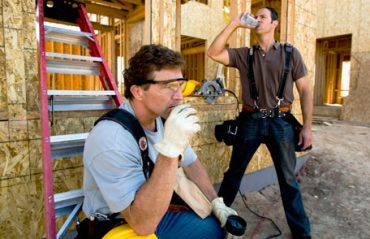
John Bleasby
Dehydration: A worksite’s silent summertime hazard
Canadian ContractorHeat exhaustion is a serious health risk that's easy to avoid
“Summer time…and the livin’ is easy!” Or maybe not so easy because it’s so darned hot! Working on a construction site in the heat and blazing sun is tough on both the mind and the body. Did you know that in severe cases, a person can actually die due to overheating? It’s all about dehydration, and every worker and site supervisor needs to be aware of the causes, prevention measures, and emergency procedures.
A preventable health hazard
Dehydration is a problem that should never occur. As the American Society of Safety Engineers (ASSE) points out in a technical brief, “It is frustrating because nearly every heat-related illness or death is completely preventable. With greater awareness of the potential hazards and the use of simple, common-sense solutions, heat-related illnesses need not happen.”

Give your workers ‘cool-down’ breaks during the day so they can rest and hydrate their bodies
Many treat the heat as simply an annoyance that accompanies summer work. As the ASSE points out, seeking shade, air conditioning, or fans is fine if you are at home or in an office. However, on a worksite that isn’t always possible. “The human body can only handle so much heat before it suffers serious damage.”
Here’s what happens when we get hot
The body tries to maintain a constant 98.6 degree body temperature by sweating to cool itself. Problems occur when sweating isn’t enough. The body attempts to reabsorb fluids from the blood and other tissues. Heat rashes might be the first sign of a problem….clusters that might appear as pimples or blisters in areas that normally are sweaty. When heat cramps in the legs or the abdominal area, nausea, dizziness, weakness and confusion are observed, a serious problem is at hand.
“Joe doesn’t look right! What do we do?”
Here are some on-site actions that can be taken if a co-worker appears to be suffering from heat exhaustion:
Move to a cooler, shaded area.
Drink water
Apply wet towels to the neck, face and head
If symptoms worsen or don’t respond, call for medical attention. Every minute counts.

To encourage regular water intake, place a water dispenser on site
Things never have to get to this stage
If you are a supervisor, educate your crew. The best way to prevent dehydration is to drink plenty of liquids throughout the day, starting before the work begins. If necessary, provide water on your job sites, allow more time for cool-down breaks, provide an air-conditioned trailer if possible, and if the work can be moved, move it to a shady area. You might even consider scheduling work each day in order to avoid tasks that involve high exertion on the hottest days or when the temperatures peak, often the early afternoon..
Advise your workers that caffeine-loaded drinks and soft drinks can actually make things worse by increasing urination. Water is the best thing, about 8 – 10 glasses each work day, although some sport drinks are good too. Energy drinks should be avoided completely. (See previous Canadian Contractor coverage of that subject).
What did mother say?
“An ounce of prevention is better than a pound of cure.” In the case of summer time hydration, it makes good sense to hydrate in advance with a few ounces in the morning and then continue to hydrate as the day continues.
follow John on Twitter 
@john_bleasby

Leave a Reply